| TENURE |
COMMISSION BIOGRAPHY |

1848
|
Ambrose Servier
Appointed by President James K. Polk in December of 1848.
He is known as The Father of Arkansas Statehood. He was a Jacksonian Democrat and was elected as the first member of the United States Senate from Arkansas. Unfortunately, he died before he could be confirmed by the Senate. |

1848
|
John B. Weller (b. 1812 - 1875)
He was a one-term Congressman (D) from Ohio and headed the United States Commission after Ambrose Sevier's untimely death. During his tenure, the United States Commission met formally for the first time with the Mexican Commission headed by Commissioner Pedro Garcia Conde. The joint Boundary Commission ran the portion of the line from the Pacific Ocean to the junction of the Gila and Colorado Rivers. Weller and Mexican Commissioner Pedro Garcia Conde established the boundary from San Diego to the Colorado River. He served for one year as U.S. Commissioner, but after a scandal was removed from the Commission. In 1850 he moved to San Francisco and became a California Congressman. He was then elected to the U.S. Senate in 1852, where he served until 1857.
|

1849
|
John C. Fremont (b.1813 - 1890)
Appointed by President Zachary Taylor, he was Commissioner long enough to clear his name for treason. Born in Savanannah, Georgia on January 21, 1813. He was educated at Charleston College and taught mathematics before joining the Army Topographical Engineers Corps in 1838. The following year Fremont joined a party led by Joseph N. Nicollet, that surveyed and mapped the region between the upper Mississippi and Missouri rivers. In the winter of 1848 and 1849 Fremont led an expedition to locate passes for a proposed railway line from the upper Rio Grande to California. During the Californian Gold Rush, gold was discovered on his estate and he became a multi-millionaire. When California achieved statehood, California leaders offered him the opportunity to be their Senator.
|
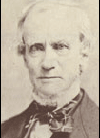
1850 - 1853
|
John R. Bartlett (b. 1805 - 1886)
Appointed by President Zachary Taylor in 1850. John Russell Bartlett was born in Providence, Rhode Island and was raised in Kingston, Ontario. In 1836, he became a resident of New York City, and in 1840 opened a book store with Charles Welford, specializing in science and literature and foreign books which they imported. This business failed, and in 1850, with political connections and an interest in Indian languages, Bartlett applied for and was appointed by President Zachary Taylor to be United States Commissioner for the United States Mexico Boundary Survey. One of his jobs was outfitting the survey party, and he hired his friend Henry Cheever Pratt to be the official artist, but sketches by Bartlett were in the final report. The survey party traveled through Texas, New Mexico, Arizona along the Gila River, Mexico and California. His participation in the survey was controversial because he frequently wandered away from the official party to find Indians for his language studies but charged these outside expenses to the Survey. On June 15, 1850, thanks to his standing in the Whig party, Bartlett was appointed United States Boundary commissioner to carry out the provisions of the Treaty of Guadalupe Hidalgo. Despite his ignorance of the Southwest he accepted this post because he wanted to travel, because he wanted to see Indians, and because he needed the money. Bartlett left New York with a large party on August 3, 1850, and landed at Indianola, Texas, twenty-seven days later. After traveling overland, he arrived at El Paso del Norte (Juárez) to begin work with the Mexican Boundary Commissioner, Pedro García Conde. The point where the southern boundary of New Mexico was to begin on the Rio Grande proved difficult to determine because of inaccuracies in Disturnell's 1847 Map of the United Mexican States, and Bartlett allowed the boundary to be set forty-two miles north of El Paso. When American boundary surveyor Andrew B. Gray refused to agree to this, Bartlett departed for a tour of northwestern Mexico. He arrived in California, then traveled east through Arizona and New Mexico to Texas, where he learned that Congress had rejected the Bartlett-García Conde line. Because of Bartlett's error, the United States in 1853 had to negotiate the Gadsden Purchase, which set the boundary of New Mexico at 31°47' north latitude. The Gadsden Purchase, which transferred mainly desert lands to the United States, was viewed as essential for establishing a southern route for the transcontinental railroad. Read The Quinceañera, the Commission, and a Rescue in the Night The Story of Inez Gonzales Told by Gabriel Duran, Design Engineer with theInternational Boundary and Water Commission United States Section."
|
 1854 - 1857 1854 - 1857
|
William H. Emory (b. 1811-1887)
William H. Emory was born at Poplar Grove estate in Queen Anne's County, Maryland, on September 7, 1811. He attended the United States Military Academy, West Point, New York, and graduated in 1831. He is known as an Army officer and boundary surveyor of Texas. He resigned from the army in 1836 to work as a civil engineer but returned to the service in 1838. That year he married the great-granddaughter of Benjamin Franklin, Matilda Wilkins Bache of Philadelphia; they had three children. In the coming years, as a lieutenant, captain, and major in the topographical engineers, Emory specialized in exploration and conducting boundary surveys along the Texas-Mexican border. As a member of the Topographical Engineers, he served on the United States/Canadian Boundary Commission and the United States/Mexican Boundary Commission. That survey included an exploration of the Big Bend region of the Rio Grande. His appointment was short lived because the survey was definitively canceled later that year. Emory's maps and reports made him the foremost authority of the trans-Mississippi Southwest in the United States. He came to public attention as the author of “Notes of a Military Reconnaissance from Fort Leavenworth in Missouri to San Diego in California”, published by the Thirtieth Congress in 1848. This report described terrain and rivers, cities and forts, pueblos and prehistoric ruins, animals and plants, and Indians and Mexicans, primarily in New Mexico, Arizona, and Southern California. It was then and later considered one of the important chronicles and descriptions of the Southwest, especially for its maps. Emory was a reliable cartographer and drew dozens of maps of the West. He participated in the surveys of the United States-Mexican border (1848-53), and the Gadsden Purchase (1854-57). His accurate rendering of the topography usually made other maps obsolete. He acquired his greatest fame as supervisor of the United States-Mexican boundary survey between 1848 and 1853.
|

1892 - 1896
|
John W. Barlow
During the battle of Williamsburg men of his section were swept back by a rush of Confederate Cavalry. Lieuteannt Barlow, with a single soldier to help him, threw one of the guns into the battery, loaded and fired it in face of enemy, and fought them off. At Hanover Court House he took one gun to the picket line, and with it repelled a Confederate regiment with canister shot. He was commended by General George McClellan for this action, and was brevetted Captain. At the end of July 1862, he was transferred to the Topographical Engineers, and in March 1863 to the Corps of Engineers.
He served as Assistant Professer of mathematics at West Point for 6 months, also teaching geography, history and ethics (they were short-handed at USMA in those days).
In June 1863, he returned to Army of the Potomac and fought through Gettysburg. From that point on he built a number of bridges, including one over the Rappahannock at Kelly's Ford, November 1863. In February 1864 he returned to the mathematics dept. In June he went to Georgia and served as chief engineer of Sherman's XVII Army Corps. On sick leave from August to November and then back in charge of the defenses of Nashville. He was still in the West when the war ended.
He stayed in the engineers and supervised construction of forts in Florida, New York and Connecticut. He worked on harbors on the Great Lakes and along the Hudson River. He was involved in opening a canal at Mussell Shoals. In the 1870's he conducted a geological study, under Dr. F. V. Hayden, which became first government exploration of the Yellowstone Region. His work resulted in the formation of Yellowstone National Park, and its publication gave him a lasting place in the country's history. A great part of his valuable collection of data and photographs was destroyed in the Chicago fire, as was his first copy of Cullum's Register. He Promptly ordered three copies of the register, and completed his admirable report on the exploration from memory. In 1872 he accompanied a surveying expedition for the Northern Pacific Railroad. The party was attacked by 1,000 Indians under Sitting Bull. The attack repulsed by an escort of 400 men. His report of the expedition was highly praised by General William T. Sherman.
In the 1890's, he commanded a joint commission of engineers from both countries who worked together surveying and placing permanent markers between the US and the Mexican Republic from El Paso to the Pacific Ocean. On May 2, 1901 he became Brigadier General and chief of the corps of engineers, retiring from active duty the next day.
He was one of the classmates that Ames had described as being "seized by a perfect mania for getting married." He married Hessie McNaughton Birnie in the Church of Epiphany, Washington, DC, on the day after Christmas, 1861. They moved to a honeymoon home at 55 Pennsylvania Avenue. Mrs Barlow died many years later, and the widower married Alice Stanton Turner on September 17, 1902. After he retired, they made their home in New London, Connecticut.
In 1912-1913 he was President of the Association of West PointGraduates. In the winter of 1913-14, the couple took trip to the Holy Land. There taken ill. Died in Jerusalem, February 27, 1914, at the age of 76. His funeral was held 2 months later at Fort Myer, Virginia, with burial in Arlington National Cemetery.
|
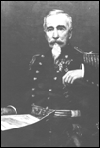
1894 - 1914
|
Anson Mills (b. 1834 - 1924)
He was born in Thorntown, Indiana, on August 31, 1834, the son of James P. and Sarah (Kenworthy) Mills. He was a pioneer, soldier, inventor, and explorer. He attended school in Indiana and New York and dropped out of West Point ("because the math was too hard") and came to El Paso, Texas (then called Franklin) in 1858 where he was appointed District Surveyor and surveyed Forts Quitman, Davis, Stockton, and Bliss, all in West Texas. In 1859 he submitted a street map of a settlement he called "El Paso." Downtown El Paso is still laid out almost exactly as he planned it. Just before the Civil War, he failed to talk the commander at Fort Bliss out of surrendering the federal fort to Confederate forces and was run out of town by Confederate sympathizers. He returned to Washington and enlisted and accepted a commission in the Union Army . While in the military, Mills designed and patented the woven ammunition belt which made him very wealthy. He later also fought in the Indian Wars, retired as a brigadier general and returned to El Paso as United States Boundary Commissioner where he reestablished the Mexican border on the island of San Elizario and straightened the Rio Grande by severing the Córdova banco, an improvement that relieved serious flooding in El Paso. He also advocated a major international dam at El Paso, which eventually went to Elephant Butte in New Mexico 120 miles north. He practically wrote the Mexican treaty, An Equitable Distribution of the Waters of the Rio Grande, which promised Mexico an annual 60,000 acre-feet of water. He also wrote the 1905 treaty for the elimination of bancos. As the American boundary commissioner he refused to accept the 1911 arbitration agreement that gave the El Paso Chamizal to Mexico. He built the Overland Building, which for three decades was the largest structure in El Paso and at that time was the largest concrete monolith in the world. His accomplishments were many and the City of El Paso renamed St. Louis street to Mills Street. Mills retired from the Boundary Commission in 1914 and died in Washington, D. C. in 1924. He was buried with honors in Arlington National Cemetery.
|
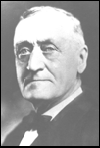
1917 - 1921
|
Lucius D. Hill
Appointed by President Wilson. From 1886 to 1890, Judge Hill was a member of the Tennessee State Legislature, and was a member of the State Senate in 1923 and again in 1925, when he served as Speaker of the state Senate. He served as International Boundary Commissioner between the United States and Mexico from 1917 to 1921. |

1922 - 1926
|
George Curry - (b. 1861 - 1947)
He was appointed Boundary Commissioner by Warring G. Harding and Fired by Calvin Coolidge
George Curry was born on April 3, 1861 at Greenwood Plantation in West Feliciana Parish, Louisiana. At the age of nine he lost his father who had been a captain in the Confederate army. He was from New Mexico he met Billy the Kid, was a Rough Rider with Teddy Roosevelt, Fought during the Spanish American War and served in the Philippines. Served as the Territorial Governor of a region of the Philippines and as a Territorial Governor of New Mexico. He was appointed the first Commissioner after the Mexican Revolution.
Curry’s career in the Spanish-American War was a rather short one. In April 1898 New Mexico governor Miguel Otero appointed Curry captain of Troop “H”, one of the four New Mexico troops. The troop received a few days of training in San Antonio Texas, and with the other three New Mexico troops (“E”, “F”, and “G”) formed the second squadron of the First U.S. Volunteer Cavalry, commanded by Colonel Leonard Wood. On May 29 the regiment was moved by rail to Tampa, Florida.
When a new county (Otero) was created in 1899 from parts of Lincoln County, he moved to Alamogordo and became County Sheriff. In 1904 President Theodore Roosevelt asked Curry to accept an appointment as governor of Isabela Province, in the extreme north part of Luzon. He served in that office and a following one as governor of Samar province until 1907, returning to the States to become governor of New Mexico Territory from 1907 until February 28, 1910.
Curry’s engagements in New Mexico politics and as a businessman are almost too numerous to mention. At various times and in various places he dealt in real estate, in oil, and operated a hotel. He recruited four companies for World War I service, served on the International Boundary Commission (1922-1926), and in World War II was chairman of the draft board. In 1945 he became the first State Historian of New Mexico, a state whose history he had a large part in shaping.
George Curry died in the Veterans Hospital in Albuquerque on Novemver 24, 1947 (Thanksgiving).
|
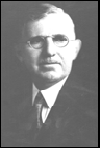
1927 - 1954
|
Lawrence M. Lawson
The longest serving US Commissioner in history, covering 27 years from 1927-1954.
He came to the Commission with extensive prior experience as an engineer in charge of topographic surveys for the Department of the Interior and, later, as project engineer for the Rio Grande Reclamation Project; during his tenure in that post, Elephant Butte Dam (SHOW PHOTO OF THE DAM) and related irrigation works were completed, making life as we know it in Southern New Mexico, El Paso, and Cd. Juarez possible as the waters of the Rio Grande could be captured and then released to sustain farms and cities.
At the IBWC, Commissioner Lawson won wide recognition as “the tamer of the Rio Grande”. One of his first achievements was to reach agreement with Mexico on trading areas or “bancos” detached from one country or the other by the capricious Rio Grande. This agreement was memorialized in the Convention of February 1, 1933, resulting in the Rio Grande Rectification Project between El Paso and Fort Quitman, which eliminated river curves, a cause of numerous costly floods and shifts in the boundary. Thousands of acres in land were exchanged between countries as the international river boundary in this section was reduced from 155 miles to 88 miles.
Following completion of the Rectification Project in 1938, Commissioner Lawson proceeded with a $4 million Canalization Project above El Paso, which provided a stable and contained river channel, protecting residents from floods while ensuring delivery of Rio Grande water to the region’s users. He also presided over construction of American Dam in El Paso which, to this day, diverts Rio Grande water into the U.S. canal.
Surely the greatest accomplishment during his tenure at the IBWC was the 1944 Water Treaty, which settled the problem of dividing the waters of the Rio Grande and Colorado River between the two countries and established the modern-day IBWC. This settlement was based on an engineering report made by the Commission and in fact, the treaty formally changed the name of the Commission from the International Boundary Commission to the International Boundary and Water Commission. The 1944 Water Treaty resulted in completion of Falcon Dam in 1953. Commissioner Lawson introduced President Eisenhower at the dedication ceremony.
In addition to his diplomatic and engineering abilities, the El Paso Herald Post reported that Lawson “had an unfailing sense of humor, spoke Spanish, played the piano, read true detective articles, and collected miniature sea horses.” He was also one of the first members of the Hall of Honor of the El Paso County Historical Society. In 1952, the Secretary of State bestowed on Commissioner Lawson the Superior Service Award, stating, “It is to his credit today the Mexican border can be cited to the world as a living example of the ability of free people to solve mutual problems on a friendly basis.”
Joseph Friedkin, long-time boundary employee and Commissioner at the time of Lawson’s passing in 1963, wrote, “The foundation of the work we are doing today was laid by Mr. Lawson. He has left with us a great inspiration, a great pattern of developing projects along our international boundary with Mexico for the benefit of our two countries, and it is this to which our present Commission is dedicated to carry on.”
|

1954 - 1962
|
Leland H. Hewitt
Mr. Hewitt graduated from the United States Military Academy and earned a degree in civil engineering from the Massachusetts Institute of Technology. He was commissioned in the U.S. Army Corps of Engineers where he achieved the rank of Colonel and earned the Silver Star, the Legion of Merit, and the Purple Heart. Prior to his appointment to the International Boundary and Water Commission, United States and Mexico, he was also associated with the International Joint Commission, United States and Canada, which dealt with waters on the northern boundary.
During his leadership at the IBWC, Commissioner Hewitt concluded minutes related to operation and maintenance of the new Falcon Dam, and plans for construction of Amistad Dam and Anzalduas Diversion Dam
|
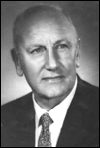
1962 - 1986
|
JOSEPH P. FRIEDKIN
Mr. Friedkin was born in New York City, the son of a Russian-born tailor and an American mother. Attended El Paso High and the Texas College of Mines (now UTEP) where he served as Student Body President and helped to organize the first College of Mines Band. He was appointed by President Kennedy and is the 2nd longest serving Commissioner in , 1962-1986, serving in the administrations of Presidents Kennedy, Johnson, Nixon, Ford, Carter, and Reagan. In 1968, President Johnson accorded Commissioner Friedkin the personal rank of Ambassador.
Began work at the USIBWC in 1934 and served the Commission for 48 of the next 52 years, with postings in Calexico, San Diego, and El Paso.
Conducted field investigations for the 1944 Water Treaty and Served as Supervising Engineering for construction of Falcon Dam. He was a Technical Advisor to the Department of State in negotiating the Chamizal Treaty (1963) that settled the centurylong boundary dispute between the United States and Mexico in El Paso-Juarez. He was known as the architect of the Chamizal Treaty. He was instrumental in the completion of construction of Amistad Dam at Del Rio. So much so that upon his retirement, the Del Rio Rotary held a special luncheon in his honor. As the local newspaper reported, “The Rotarians pulled out all of the stops to express admiration for Friedkin.” He also had a key role in the settlement of the salinity problem on the Colorado River and implemented the 1970 Boundary Treaty
He received State Department’s Superior Honor Award in 1964 for superior service in the discharge of duties of the United States Commissioner and the Distinguished Honor Award and gold medal from Sec. of State George Schultz in 1986. Excerpt from the award, “Under his capable leadership, the IBWC has been a prime example of effective US-Mexico cooperation and a model of its kind throughout the world.” In 1980, Mexican President Jose Lopez Portillo presented him with the Pan American Engineering Award of the Pan American Union of Associations of Engineers in Mexico City. As a longtime friend and El Paso’s Collector of Customs Ray Dwigans said, “They picked a hell of a good man. The record shows that. He’s very serious in his work and he’s smart. He’s really straightened that boundary commission out. And no tainted brush has ever been put on Joe Friedkin.”
Following Hurricane Beulah in 1967, Friedkin toured the Lower Rio Grande Valley by helicopter with President Lyndon Johnson. As they flew over the homes of Lloyd Bentsen and the late V.F. “Doc” Neuhaus, LBJ told Friedkin, “You be damned sure you don’t flood them.” They were flooded the next day, Friedkin recalled in a 1986 newspaper interview. Soon after that, the Commission received appropriations for the Lower Rio Grande Flood Control Project. Congressman Kika de la Garza of the Lower Rio Grande of Texas praised Friedkin in 1974, noting, “I have known and worked with Commissioner Friedkin before and since my election to Congress in 1964. Through all these years I have observed his determination and dedication not only to improve relations with our neighbor to the south that fall within his responsibilities but also to improve the quality of life for the people living along the United States-Mexican border.” During Friedkin’s tenure, President Lyndon Johnson went to El Paso for the 1968 dedication of the Chamizal project and President Richard Nixon to the Amistad Dam dedication the following year. “I had the good opportunity to meet both of them,” Friedkin recalls. “They both seemed to be very pleased with what we had done working with Mexico.” The biggest change Friedkin saw during his years at the Commission was the development of the border, noting in a 2001 interview, “The cities and towns grew and we grew with then. We resolved a lot of differences which facilitated business along the boundary.”
He also attributed his success in part to the excellent relationship he had with Mexican Commissioner David Herrera Jordan which allowed the two Sections to reach agreement to develop and implement joint projects.
|
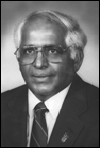
1986 - 1994
|
Narendra N. Gunaji
Appointed by President Reagan and a native of India, Commissioner Gunaji received his B.S. degree in Engineering from the University of Poona, later earning masters and doctorate degrees in hydrology and water resources from the University of Wisconsin. Prior to his appointment to the Commission, he served as Professor of Civil Engineering at New Mexico State University.
Under his leadership, the Commission made significant advances in its sanitation work, including:
Expansion of the Nogales International Wastewater Treatment Plant, which treats sewage from the cities of Nogales, Arizona and Nogales, Sonora. The $12 million project doubled the plant’s treatment capacity.
Agreement to construct the Nuevo Laredo International Wastewater Treatment Plant, the first treatment plant for Nuevo Laredo, as a binational project funded by both countries.
Agreement to construct the South Bay International Wastewater Treatment Plant and Ocean Outfall in San Diego, California. This project intercepts sewage from Tijuana to provide for its treatment in the United States, with discharge of the effluent offshore.
Agreement to conduct binational water quality studies, leading to important research of the quality of the waters of the Rio Grande
Commissioner Gunaji once told a reporter, "In the United States I have always tried to participate in the workings of government. I served on the Las Cruces City Council. Now I serve as commissioner. I am happy such an honor has been bestowed upon my family.”
Commissioner Gunaji also has the unfortunate distinction of having survived a plane crash. The USIBWC once owned a small airplane, courtesy of the federal government’s program of seizing assets from drug traffickers. However, the agency did not have its own pilot, relying instead on contract pilots. As the Commission plane was landing in Nogales, Arizona, the pilot forgot to engage the landing gear. Although the plane was destroyed, Com. Gunaji and his staff survived without serious injury.
|

1994 - 2000
|
John M. Bernal
Mr. Bernal was appointed by President Bill Clinton. Prior to his appointment to the USIBWC, Bernal served as Director of the Pima County Department of Transportation and Flood Control District in Tucson, Arizona. As Commissioner, Bernal achieved numerous noteworthy accomplishments. Among them, he concluded 15 major Treaty Minutes. These agreements relate to: various sanitation projects in the border region; a binational feasibility study for an aqueduct to bring water to San Diego and Tijuana; operations and maintenance of the Bridge of the Americas in El Paso/Cd. Juarez; improvements to the conveyance capacity of the Colorado River; conceptual framework for development of binational studies and recommendations related to the ecology of the Colorado River delta; and enhanced demarcation and monumentation of the boundary at the international bridges and ports of entry.
He also provided critical leadership for the start-up of the Border Environment Cooperation Commission (BECC), a binational organization established as a side agreement to the North American Free Trade Agreement for the purpose of helping border communities develop environmentally-sound potable water, wastewater, and solid waste projects. Since the BECC’s inception, Commissioner Bernal has also provided key leadership on the organization’s Board of Directors.
Commissioner Bernal’s accomplishments include:
- Replacement of the Bridge of the Americas in El Paso/Cd. Juarez
- Construction of international wastewater treatment plants in San Diego and Nuevo Laredo
- Completion of the Rio Grande American Canal Extension in El Paso
- Construction of the Rio Bosque Wetland Park in El Paso
- Initiation of the Texas Clean Rivers Program in the Rio Grande Basin under contract with the State of Texas
- Establishment of the Rio Grande Citizens’ Forum to facilitate the exchange of information between the USIBWC and the public about the agency’s Rio Grande projects from Percha Dam, New Mexico to Fort Quitman, Texas
- Provided critical leadership for the start-up of the Border Environment Cooperation Commission (BECC); continues to provide key leadership on the BECC Board of Directors
- Establishment of a Quality of Work Life program for USIBWC staff boundary-wide to improve employee morale and productivity
- Initiation of a strategic planning process for the agency and establishment of a USIBWC mission statement.
|
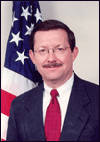
2001 - 2002
|
CARLOS M. RAMIREZ
Appointed by President George W. Bush in July of 2001. Prior to his appointment to the IBWC, Ramirez served as Mayor of El Paso, Texas, the nation’s 17th largest city, for two terms from June, 1997 until June, 2001. Mayor Ramirez was Chief Executive Officer of the City, presided over City Council, and supervised all City departments. El Paso has a strong mayor form of government.
As required by treaty, Commissioner Ramirez is an engineer, having earned both undergraduate and graduate civil engineering degrees from the University of Texas at El Paso. He also obtained his professional engineer certification. He was President of the El Paso Chapter of the American Society of Civil Engineers and was elected to the Tau Beta Pi National Honorary Engineering Society and the Chi Epsilon National Honorary Civil Engineering Society. He was also a member of the Airport Architectural Review Committee for the City of El Paso.
During his tenure at the USIBWC, Commissioner Ramirez addressed one of the most vexing issues in the U.S.-Mexico relationship – that of Mexico’s deficit in delivery of water to the United States in the Rio Grande. Commissioner Ramirez and his Mexican counterpart, Commissioner Arturo Herrera, concluded two agreements on the subject – Minutes 308 and 309 – which laid the groundwork for improved binational planning for the Rio Grande to ensure sustainable basin management.
Internally, Commissioner Ramirez brought positive change to the U.S. Section by establishing the Program and Project Management Division (PPMD). Using existing staff and resources, PPMD offers a more efficient means of cradle-to-grave project management to coordinate projects effectively among different USIBWC offices and divisions.
Commissioner Ramirez also moved the agency toward greater public participation. During his tenure, the number of Citizens’ Forum boards expanded from one to five. These community boards conduct regular public meetings in various border cities to promote the exchange of information between the USIBWC and the public about Commission activities and related projects.
Commissioner Ramirez is also well-known in the community for his efforts to foster a positive working relationship with Ft. Bliss. While Commissioner, he was honored for this work by Ft. Bliss Commanding General Stanley E. Green, who awarded him the Christiaan Petrus Fox Citizen of the Year 2001 award. This was among many awards and recognitions he has received during his career in public service.
|
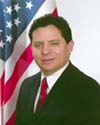
2004 -2005
|
ARTURO Q. DURAN
Mr. Duran served as United States Commissioner of the International Boundary and Water Commission from January 2004 until August 2005. In February 2004, he signed Minute No. 311, “Recommendations for the Secondary Treatment in Mexico of the Sewage Emanating from the Tijuana River Area in Baja California, Mexico.” Working in conjunction with the State Department, he also reached agreement for resolution of Mexico’s longstanding deficit in water deliveries to the United States in the Rio Grande basin.
In 2003, he was appointed by the President to the Joint Public Advisory Committee (JPAC) of the Commission for Environmental Cooperation (CEC) of North America and to the Selection Committee of the North American Fund for Environmental Cooperation of the CEC.
Previously, Mr. Duran served as General Manager of the Lower Valley Water District located in El Paso County, an organization responsible for providing potable water, sewer, solid waste, parks and recreation, and flood control services to several communities. He also worked for the U.S. Environmental Protection Agency for over nine years managing environmental restoration and waste management programs.
|

